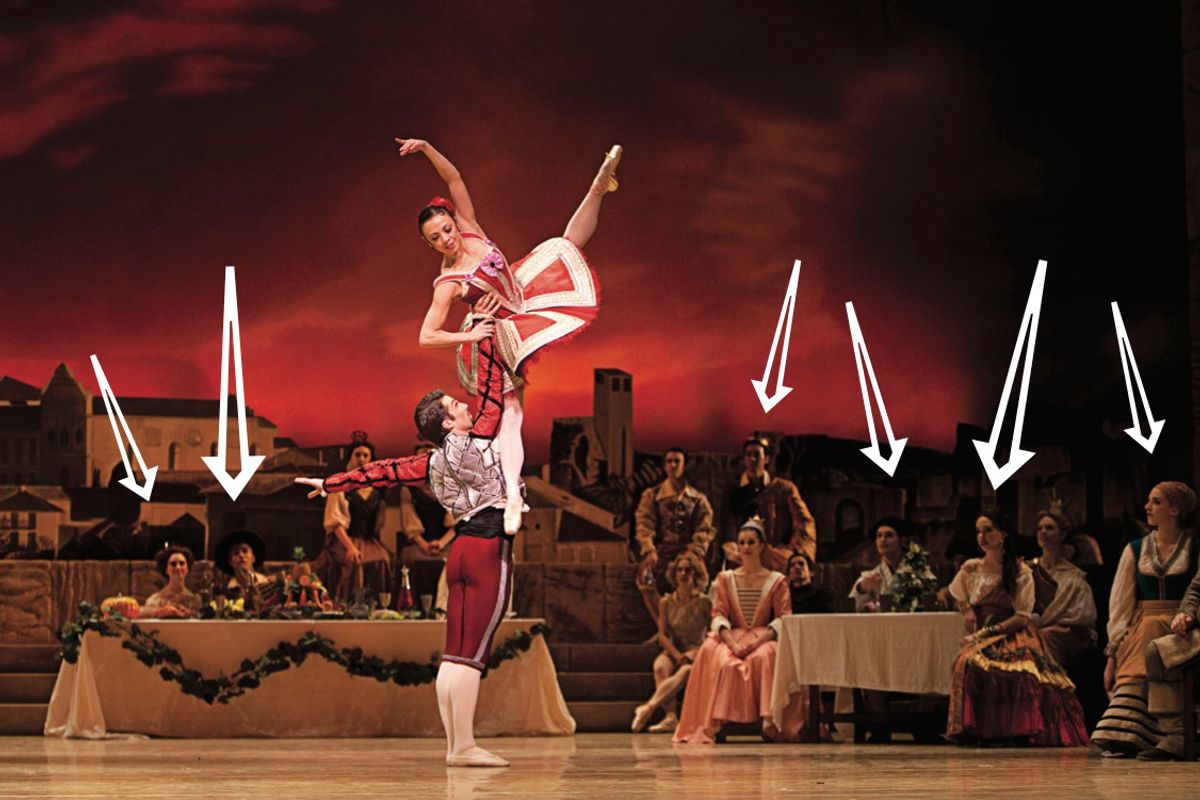Smile! You're Living Scenery: Finding the Silver Lining in Non-Dancing Roles
Everyone has to start somewhere. It’s a mantra you may repeat to yourself time and time again when you see your name next to less-than-desirable roles on the cast list. Perhaps it’s the townsperson, the courtier or the garland girl—that character that makes you feel more like part of the scenery than part of the company. Some dancers seem to leapfrog over or power through this initiation stage, getting cast in featured roles during their first professional season. But the majority of us have to come to terms with standing by the backdrop for a few years, mime-clapping for the soloists at the front.
No matter what stage you are at in your career, you’ve likely dealt with the frustration of being cast in small dance-sparse roles. But these three dancers show that remaining positive in the face of disappointing casting pays off, both for your peace of mind and your future opportunities.
Confidence When It Counts
For sixth-year Ballet West corps member Ronald Tilton, his average role is higher up the totem pole than it used to be. For example, last season he performed Death in Kurt Jooss’ The Green Table. But he’s no stranger to being “the guy in the goofy wig literally standing there for half an hour.” The Sleeping Beauty was one of his first full-length ballets when he joined the company, and he remembers struggling to simply remain motionless onstage as a courtier. “I thought I was standing still,” he says, “but then over the God mic they said, ‘Ron. Don’t. Move.’ ”
Tilton has since mastered the art of micromovements so as to not conspicuously squirm, but performing supernumerary parts “where you hand a stick to the prince and that’s your role,” has had other valuable lessons. Namely, not to get dispirited. “It’s important to want to dance more, but not get discouraged when you’re not,” Tilton says. He finds that walking into a little role with the goal to kill it, no matter what it is, not only impresses your director, but the can-do attitude will also become a healthy habit, building your confidence stores for when you do land that coveted featured part.
Act Like You Mean It
Acting isn’t always taught in school, says Orlando Ballet dancer Blair Bagley, but it’s something that you’ll call upon at every stage in your career. She says that when American Ballet Theatre ballet mistress Susan Jones came to set Don Quixote on Orlando Ballet in 2016, she told a story about a corps member making it into a newspaper review for his acting in the background. The skills translate when you graduate from townsperson to featured dancer, Bagley notes.
Yet in a company without ranks, where everyone technically has a fair shot at featured parts, it can feel harder to come to terms with being cast in small non-dancing roles. Bagley says it comes down to putting in your time. She worked her way up from Orlando Ballet II to joining the main company in 2012. Once there, her lot often amounted to roles like “friend” in Romeo and Juliet, “village person” in nearly every ballet in the classical cannon or “flower” (with a costume that looked more like grass) in Peter and the Wolf. “I wasn’t born with crazy feet and legs,” she says, noting that her rise to roles like Dew Drop in The Nutcracker and pas de trois in Swan Lake hasn’t been meteoric.
“You have to swallow your pride.
Being the girl in the corner crying about your role
is not going to help.” —Blair Bagley
But hard work and keeping a good attitude have made all the difference. “You have to swallow your pride,” she admits. “Being the girl in the corner crying about your role is not going to help.” Her advice? Take a moment if you need to upon first reading the casting, but then keep your head up, do your job and keep smiling. When you look back on this time in your career, you’ll be a lot happier with yourself if you had a good attitude.
Patience and Purpose
First year Pacific Northwest Ballet corps member Amanda Morgan sometimes finds herself in an awkward position during casting. “I’m the only black woman in my company right now, and I’m also very tall,” she says. On the one hand, she acknowledges that these things have helped her stand out—as an apprentice she got to perform the character Rosalia in West Side Story Suite—but it also means she’s sometimes left out of the action altogether. Because of her height (about 5′ 11″), she says, “I’m not always used for a lot of corps stuff.”
Thus, Morgan has learned to appreciate every moment she gets to be onstage. It’s also key for her to have an open dialogue with her boss. “I’ve had this talk with my director so many times, to just be patient,” she says. “Some people move fast up the ranks, and for other people it takes more time. I don’t know what’s going to happen for me, but I’m taking it day by day.”
And in Morgan’s opinion, a back-seat view is underrated. As onstage “scenery”—a gypsy in the background during Don Quixote‘s wedding scene, for example—she’s perfectly placed to watch and learn from the principals dancing mere feet away. She also loves the camaraderie of being part of a town scene or corps. No matter how much dancing a role requires, she says, “it’s about making something beautiful, something bigger than yourself.”






